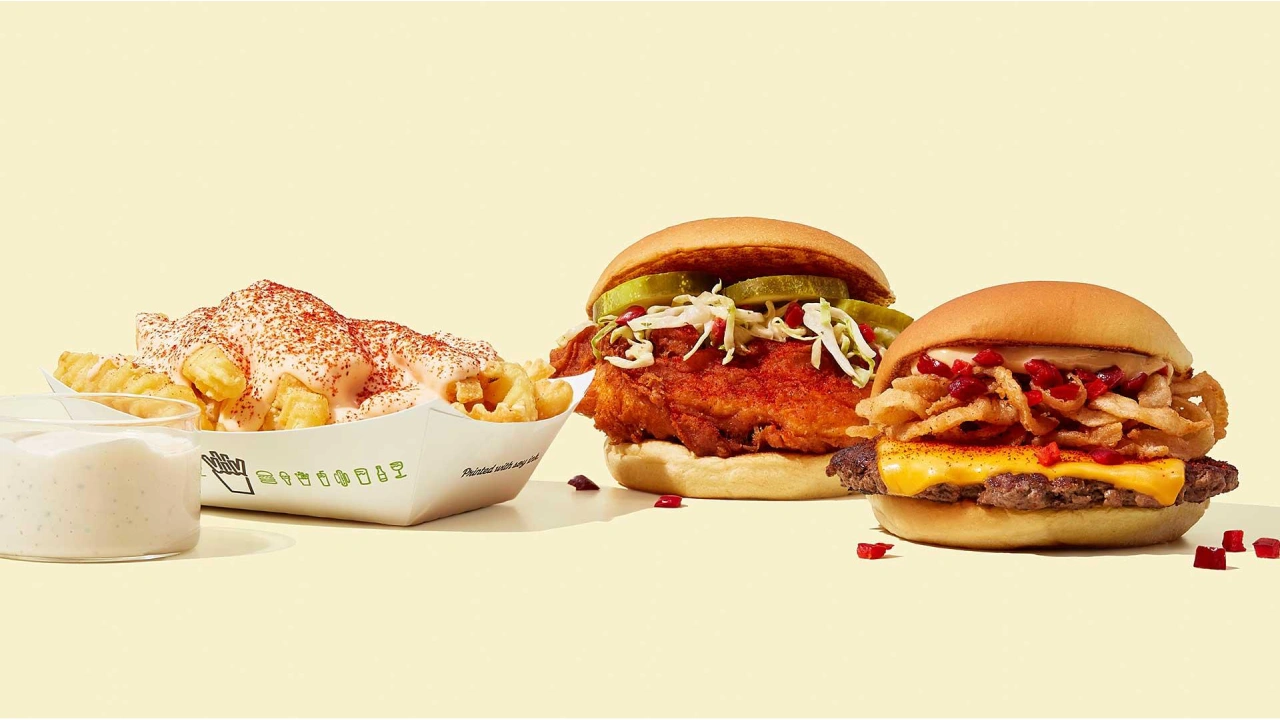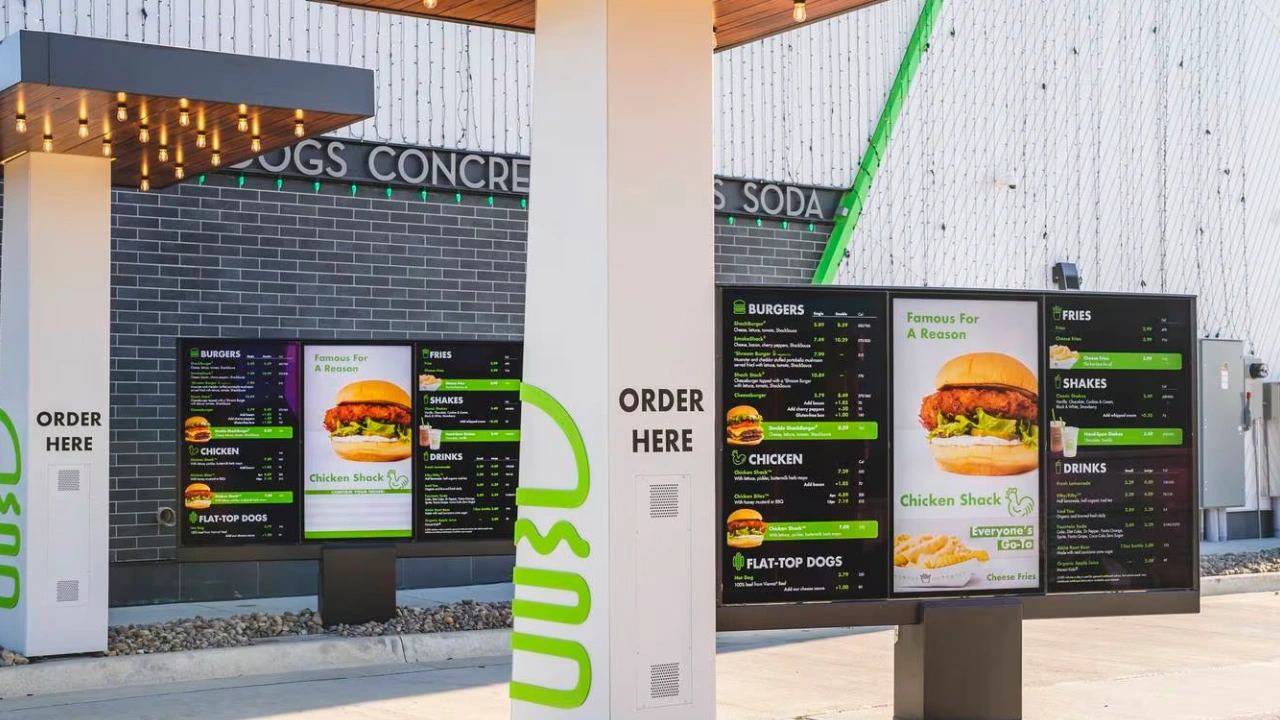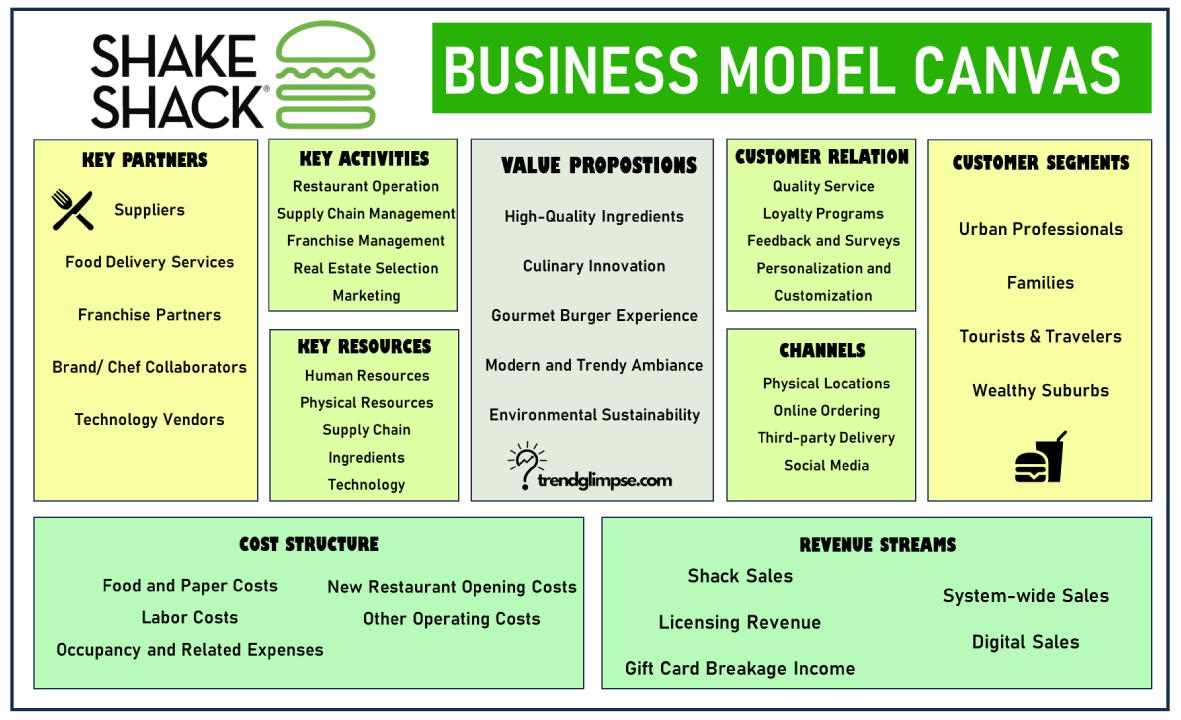What is Shake Shack?
Shake Shack has become the burger joint to beat these days. This once little hot dog cart in Madison Square Park has exploded into a booming franchise with over 200 locations globally. It seems everyone is clamoring for a bite of these juicy burgers and creamy frozen custards.
Originally founded in 2004 by Danny Meyer, Shake Shack was created as a simple hot dog cart in NYC to support the Madison Square Park Conservancy. Word quickly spread about their delicious food, causing perpetually long lines each season. By 2012, Shake Shack had become so popular that Danny Meyer took the concept from park stand to restaurant establishment.
Headquarters: New York City, New York, United States
Industry: Restaurants
Current CEO: Randy Garutti
Annual Revenue [2023]: US$ 900.5 Million
Employee Count: ~8,000
Website: Shake Shack
Now in 2022, Shake Shack pulls in over US$ 900.5 million, up 21.7% from 2021. They have an extremely loyal customer base with urban millennials making up much of their demographic. On average, individual Shack locations bring in $4 to $5 million per year. Their social media presence is strong as well, with over 500,000 Twitter followers keeping up with their latest announcements.
Just recently, Shake Shack unveiled new locations in Boston, Detroit and Toronto while announcing plans with GrubHub to expand their delivery reach. They have over 440 locations globally, with continued expansion and a commitment to quality.
Burgers, Chicken bites, Hot dogs, Crinkle-cut fries, Milkshakes, Shakes and frozen custard, Beer, Shack-made lemonade, Organic fresh brewed iced tea, Organic apple juice, Catering, Customized gift cards
Major Countries Shake Shack Operate In
United States, Bahrain, China, Japan, Kuwait, Mexico, Oman, Qatar, Saudi Arabia, Singapore, South Korea, Thailand, Turkey, United Arab Emirates, United Kingdom, and more
Competitors of Shake Shack
McDonald’s, Checkers Drive-In, Burger King, Five Guys Marketing, Smashburger, In-N-Out Burger, Subway, Steak n Shake, and Wendy’s
A Quick Overview of How Shake Shack Makes Money
- Food & Beverage Sales – The majority of Shake Shack’s revenue comes from selling food, drinks, beer, wine, etc. at their restaurants. This includes sales at both company-owned and franchised locations. Their signature burgers, hot dogs, and frozen custard make up a good portion of these sales.
- Licensing Fees – Shake Shack also makes money by licensing their brand to international affiliates and domestic airport locations. These licensing deals allow Shake Shack to generate revenue without having to open full-fledged company-owned stores in every market. Licenses get to use the Shake Shack name and food know-how.
- Merchandising – Sale of things like t-shirts, hats, cooking sauces and cookbooks with the Shake Shack brand also contribute modest amounts of revenue through partnerships with licensing companies.
Shake Shack Business Model Canvas
Customer Segments
Young Urban Professionals
Shake Shack has become a go-to spot for young urban professionals, likely making up a large chunk of their customer base. These are often single or recently-married workers living in cities, with disposable incomes that allow them to eat out frequently. Shake Shack offers a fun, trendy atmosphere paired with high-quality ingredients, at a price point accessible for this demographic seeking better fast-food. Their locations in downtown areas and business districts cater right to this crowd looking for better lunch and dinner options close to work.
Families
While Shake Shack originated more for urban Millennial and Gen Z crowds, suburban families have likely become a major source of business as well. Parents are drawn to the promise of fresh, responsibly-sourced meals compared to traditional fast food chains. The menu options appeal to kids and adults alike. Their growth into additional communities outside major cities have exposed them more to middle-class families seeking easy weekend meals, particularly as parents want to treat their children occasionally. As consumers become more health and value-conscious, Shake Shack delivers an elevated experience over typical burger joints.
Tourists & Travelers
As a New York original, Shake Shack enjoys plenty of tourism and traveler business. Their distinctive brand draws visitors in major cities like New York and Las Vegas hoping to enjoy a quintessential ShackBurger. Travelers passing through airports frequently grab Shake Shack as a better mealtime option. Their vibrant, signature style also attracts international tourists wanting a cool, Insta-worthy American dining experience. And the company’s rapid expansion means tourists across the nation can often find a familiar Shake Shack when away from home for some comfort food.
Wealthy Suburbs
While Shake Shack branches out to various communities, it continues to build new locations in affluent suburbs hoping to attract families and youth in higher-income regions. They target wealthy diners who have plenty of dining options but may be drawn to Shake Shack’s quality, trendiness and convenience. The demographics possess income levels to frequently splurge on a premium fast-food treat for the family. As Shake Shack adds unique features like drive-thrus in select luxury suburban outposts, they increase convenience for the on-the-go wealthy parent or student.

Value Proposition
High-Quality Ingredients
Shake Shack has built its brand around serving high-quality ingredients, setting it apart from typical fast food chains. They prides themselves on using premium ingredients, including 100% Angus beef patties with no hormones or antibiotics, vegetarian fed, humanely raised. Their signature ShackSauce and crinkle-cut fries also use ingredients like extra virgin olive oil and sea salt for premium quality. This commitment to ingredients helps create a more indulgent, gourmet burger experience even in a fast-casual setting.
Culinary Innovation
In terms of innovation, Shake Shack isn’t afraid to experiment with new burger creations, limited-edition concretes, and special menu items. They’ve collaborated with chefs to come up with unique offerings like the Chicken Shack fried chicken sandwich. This culinary innovation and variety keeps customers interested and excited to see what Shake Shack comes up with next. Their innovation expands the traditional burger joint menu.
Gourmet Burger Experience
Shake Shack offers a gourmet burger experience that sets it apart from other fast food chains. When you bite into one of their signature burgers, like the ShackBurger, you taste premium ingredients like a custom Angus beef patty and ShackSauce crafted with herbs and vinegar. The rich, indulgent flavors create an elevated burger experience rarely found in a quick-service setting. They pay attention to details with top-quality buns, cheese, and toppings as well.
Modern and Trendy Ambiance
When you dine at Shake Shack, you can expect a modern, upscale environment unlike typical burger chains. Many locations feature sleek, industrial-chic interiors with touches like floating ceilings, exposed pipes, and polished concrete floors. They also embrace technology with conveniences like mobile ordering and payments. This trendy ambiance reinforces that you’ll enjoy a higher-end burger experience.
Environmental Sustainability
With initiatives like sustainable sourcing, eco-friendly building materials, recycling programs, and energy efficient kitchens, Shake Shack makes environmental responsibility central to operations. For example, many stores recycle and compost front-of-house waste. They also utilize reused and sustainable materials in building restaurants. This care for the environment appeals to modern diners looking to reduce their footprint.

Channels
Physical Locations
Shake Shack has over 400 locations globally, with most concentrated in major US cities like New York, where it originated. The restaurants aim to be conveniently located in high-traffic urban areas and tourist destinations to attract foot traffic. Being situated in areas with office buildings, shopping centers, and other attractions helps ensure a steady customer flow.
Online Ordering
Shake Shack embraces online ordering and has mobile apps that allow customers to order ahead for pickup or delivery. They were early adopters of this channel, knowing busy city-dwellers would appreciate the convenience. Customers can order on their phones and skip the lines to get their ShackBurger fix faster. The digitization helps modernize operations.
Third-party Delivery Platforms
In addition to their own online ordering system, Shake Shack partners with major third-party platforms like GrubHub, DoorDash, and Postmates for delivery. Customers can order through the provider apps which expands Shake Shack’s reach. The partnerships let people get Shake Shack to their home or office, increasing accessibility.
Social Media
Shake Shack maintains an active, engaging social media presence on Instagram and Facebook centered around mouthwatering images of its food. They run promotions like free snacks for follows and shares. This builds brand awareness and loyalty, especially with younger demographics. The modern vibe presented on these channels aligns with its in-store aesthetics.
Customer Relationships
Quality Service and Hospitality
Shake Shack aims on providing high-quality hospitality and service. Staff are trained to engage customers in friendly conversations to make them feel genuinely welcomed. This personal touch helps create an enjoyable, community-oriented environment that keeps customers coming back. Maintaining exceptional service as the chain expands remains an priority.
Loyalty Programs
Though Shake Shack lacks a formal loyalty program, it fosters loyalty by emphasizing value over discounts. Reasonable prices and consistent quality makes customers feel appreciated without needing punch cards or points. However, considering rising competition, exploring customized rewards for their biggest fans could be worthwhile. A tailored Shake Shack loyalty initiative could incentivize repeat purchases.
Feedback and Surveys
Shake Shack gathers direct customer feedback through in-person conversations, comment cards, and post-purchase surveys. This enables them to stay in tune with customer preferences and make data-driven improvements. As the company grows, centralized channels to gather data may help identify broader themes. Actively responding to feedback also shows customers they are heard, deepening engagement.
Personalization and Customization
Customers feel a personal connection thanks to Shake Shack’s culture facilitating genuine interactions. Though menu customization is limited, new options like localized products and sharing packages appeal to different needs. Finding additional ways to tailor ordering or provide individualized suggestions could make experiences even more personalized. The key is maintaining that human touch as other chains turn toward automation.
Revenue Streams
Shack Sales
Shake Shack generates the majority of its revenue from sales at its Shake Shack branded stores. This includes items like its signature burgers, hot dogs, frozen custard, crinkle cut fries, beer and wine. As it continues expanding its global footprint, direct shack sales make up an increasing proportion of total revenues.
Licensing Revenue
Shake Shack also earns licensing revenue by licensing its name out to third parties. For example, it has a licensing agreement with AEON Food Supply in Japan to open Shake Shack branded restaurants in Japan. The licensing fee provides an attractive revenue stream requiring little capital expenditure from Shake Shack.
Gift Card Breakage Income
When customers don’t redeem the full value of their gift cards at Shake Shack, the company recognizes the unredeemed portion as revenue. With growing gift card sales, gift card breakage accounts for a small but meaningful source of high margin income. It allows Shake Shack to capture additional value from gift card sales.
System-wide Sales
In addition to shack sales at its own stores, Shake Shack reports system-wide sales, which includes sales from domestic and international licensed Shacks. As licensing expands globally, system-wide sales help capture the brand’s overall revenue generating power, even though licensed sales don’t directly accrue to Shake Shack.
Digital Sales
With consumers increasingly ordering online via desktop, mobile apps and delivery platforms, Shake Shack is ramping up its digital sales capabilities. Digital sales come with higher costs like commission fees, but allow Shake Shack to leverage third-party delivery infrastructure to unlock growth from new digital consumer behaviors.
Key Resources
Human Resources
Shake Shack invests heavily in its employees, whom they call “team members.” They provide above-average compensation and benefits, as well as training programs focused on hospitality, teamwork and elevating the customer experience. This focus on human resources creates friendly and motivated employees that keep customers coming back.
Physical Resources
Prime real estate is key for Shake Shack’s urban locations. They leverage small footprint stores with eye-catching design to build brand visibility and stand out in high-traffic areas. Streamlined kitchen layouts and custom equipment like the “canopy ventilation system” maximize productivity in tight spaces. This allows elevated dining experiences even in non-traditional locales.
Supply Chain and Ingredients
Shake Shack prides itself on premium, wholesome ingredients. All beef is 100% all-natural Angus with no hormones or antibiotics. They partner with Martin’s Potato Rolls to recreate the nostalgic experience which stands out from competitors with simple, high-quality ingredients. This differentiates them from competitors and justifies premium price points to quality-conscious millennial target demographic.
Technology
Shake Shack uses technology to optimize customer convenience and order speed. Their app allows mobile ordering, saving payment info, and rewards programs. Tableside Ordering tablets facilitate rapid pickup. Kitchen display systems group digital orders by type to streamline flow. This tech-integration eases ordering and improves throughput to minimize wait times, even with narrow store footprints.

Key Activities
Restaurant Operation
As a fast casual dining chain, Shake Shack’s core activity is operating its restaurants on a daily basis. This involves everything from food preparation, inventory management, staffing, customer service, sanitation, and managing in-store operations to deliver a quality experience. Efficiency and consistency across locations is critical.
Supply Chain Management
Careful supply chain management is crucial for Shake Shack to obtain quality ingredients while controlling costs. They focus on sourcing premium, sustainable ingredients from local suppliers when possible. Effective distribution and supplier relationships enable them to provide fresh food at scale across all their restaurant locations.
Franchise Management
Shake Shack leverages franchising to expand its brand footprint faster. They carefully select franchise partners, provide training and playbooks on their processes, and give operational guidance while allowing some local flexibility. Managing these franchise relationships and ensuring franchisee alignment with the company’s quality and culture standards is an important on-going activity.
Real Estate Selection
Site selection is key for Shake Shack. They strategically pick accessible, high-traffic locations in urban areas, transportation hubs, tourist destinations and affluent suburbs to drive customer traffic. Prime real estate paired with great design gives customers an elevated experiential dining environment that supports the premium Shake Shack brand.
Marketing
From grassroots PR stunts to social media engagement, Shake Shack takes an innovative approach to marketing. Promotions like themed concretes and showcasing new burgers builds buzz and social chatter. Partnerships, celebrity sightings and localized engagement deepens connections with communities and customers. This buzz marketing helps enhance brand affinity and loyalty.
Key Partners
Suppliers
Shake Shack relies on various food suppliers like Aleph Farms, Aspen Foods, Creekstone Farms, and Vienna Beef to source high-quality ingredients for its burgers, hot dogs, shakes, and more. Careful supplier selection ensures consistency and flavor. Recently, Shake Shack partnered with Aleph Farms to explore cell-cultured beef options, underscoring its commitment to innovation.
Food Delivery Services
Food delivery services like GrubHub, Uber Eats, DoorDash and Postmates are integral partners, allowing Shake Shack to extend its omni-channel presence. Customers can conveniently get Shake Shack’s signature items delivered through these apps. Such partnerships have been especially vital during the pandemic, with delivery revenue expanding over 90% in Q1 2021 as digital orders rose.
Franchise Partners
Franchise partners have fueled Shake Shack’s rapid growth. Collaborating with seasoned restaurateurs globally who understand their local markets, Shake Shack can expand its brand reach. Notably, Shake Shack partnered with Maxim’s Caterers Limited to open in Hong Kong and Macau. It’s also expanding in China, Latin America and the Middle East via licensing agreements that leverage local expertise.
Brand/ Chef Collaborators
Co-branded menu launches with brands like Pie Oh My cookie dough and chefs like Dominique Ansel capture attention. These innovative partnerships and guest chef collections allow Shake Shack to create buzz while expanding its menu options. Often tied to hot trends or celebrity chefs, they introduce new fans to the Shake Shack experience.
Technology Vendors
From digital ordering integrations to analytics software, technology vendors provide infrastructure for critical functions. Products from Toast, Square, and Hubworks enable mobile/kiosk ordering, while Reputation helps with customer feedback and Hyper provides queue management. Leveraging cutting-edge tech and best-in-class platforms is imperative for scale.
Cost Structure
Food and Paper Costs
Shake Shack’s food and paper costs make up its largest expense, accounting for nearly 30% of total revenues. These costs cover the raw ingredients and food packaging materials needed to prepare Shake Shack’s menu items, from ground beef for burgers to milkshakes and fries. Keeping these variable costs low through bulk purchasing and monitoring commodity prices is crucial for Shake Shack to maintain strong unit economics at individual locations.
Labor Costs
As a service-oriented business, Shake Shack also incurs substantial labor expenses which represent its second highest cost. Labor accounts for around 25% of Shake Shack’s total sales. To control these human resource costs, Shake Shack pays close attention to staffing levels, employee wages and benefits packages. Optimizing labor productivity through training while avoiding excessive turnover is a priority.
Occupancy and Related Expenses
With a focus on prime real estate in high-traffic areas, occupancy and facilities-related costs are also a major expenditure for Shake Shack. Rent, utilities, maintenance, property taxes and other location operating expenses make up around 16% of total revenues on average. Careful site selection and lease negotiations are key to managing this sizable cost category.
New Restaurant Opening Costs
Opening new Shake Shack locations requires substantial upfront investment, including site construction, equipment purchases, permitting, pre-opening staff training and more. These new restaurant opening expenses can total $3 million or more per location. Minimizing these start-up costs helps improve payback period.
Other Operating Costs
The remainder of Shake Shack’s operating costs include corporate overhead like support center salaries, technology systems, legal and professional services and more. Optimizing these indirect operating expenses helps keep overall costs and complexities manageable as Shake Shack continues expanding.
Shake Shack Competitors
Five Guys
Five Guys is often considered one of Shake Shack’s closest competitors. Like Shake Shack, Five Guys focuses on fresh, high-quality ingredients for its burgers and fries. A key difference is that Five Guys offers more customization options – customers can top their burgers with a wide range of free toppings. This appeals to people wanting a more tailored burger experience.
Industry experts attribute Five Guys’ success to smart market penetration strategies. As a franchise model, Five Guys has focused on getting premium real estate like street-facing retail spaces. Its bold restaurant design is also memorable for customers. Moving forward, Five Guys will likely remain one of Shake Shack’s toughest premium burger rivals.
Smashburger
Founded in 2007, Smashburger is another major better burger chain. Like Shake Shack and Five Guys, it advertises fresh, high-quality ingredients and customization options. Unique selling points include its option to “smash” burger patties for caramelization and its variety of specialty burgers.
In terms of growth, Smashburger reached over 370 locations globally by 2018 before being acquired by Jollibee Foods Corporation in 2018. Its systemwide sales were estimated at $401 million in 2017. While sizable, Smashburger still remains much smaller than Shake Shack revenue-wise. But its global expansion through the acquisition shows an ambition to potentially catch up with leading chains over time.
In-N-Out Burger
In-N-Out Burger is a popular regional chain based in the American West. Since 1948, In-N-Out has built a reputation for fresh, made-to-order burgers and a limited menu of classics. It appeals strongly to loyal West Coast customers. However, In-N-Out has not focused heavily on national or global expansion compared to Shake Shack and others.
As a private company, In-N-Out does not share revenue figures. Experts estimate its systemwide sales at nearly $1 billion annually. So among regional players, In-N-Out likely has the sales numbers to rival the national premium burger chains. Moving forward, experts say In-N-Out may eventually expand farther across the U.S. This could put it in more direct national competition with Shake Shack long-term.
Burger King
As one of the major global QSR burger chains, Burger King competes for premium burger market share even as it serves a broader customer base than the better burger players. In 2019 for example, Burger King rolled out the Impossible WHOPPER made with plant-based Impossible burger patties. This let it compete for sustainability-focused customers in the premium burger category.
Overall though, Burger King still gets roughly 75% of its U.S. sales from discounted value menu items rather than premium offerings. Revenue wise, its global systemwide sales are far higher than Shake Shack’s at $11.2 billion in 2022. Burger King isn’t positioned as direct premium competition. But its massive size means it can likely continue taking premium burger share when it chooses to focus there.
Shake Shack Future Growth Strategies
As one of the major players pioneering the “better burger” trend, Shake Shack has seen immense growth over the past decade. However, to sustain long-term success, they need to focus beyond just burgers. Expanding their menu to include more chicken, veggie, and even breakfast options can help drive sales.
Additionally, convenience and accessibility will be key – things like drive-thrus, online ordering, meal kits, and grocery store expansions allow customers to enjoy their offerings in more places. Partnerships are also a smart move, as collaborations with celebrities, athletes, and brands generate buzz.
Overall, while Shake Shack rose to popularity on its delicious burgers, diversifying revenue streams through menu innovation, enhancing convenience, and leveraging partnerships are key strategies that can fuel double-digit growth going forward and cement its status as a leader in the better burger category.

I have always been fascinated by the inner workings of companies and industries. So I decided to study business to explore it more. My goal is to take all my research and turn it into cool stories that give people a better understanding of the business world.

